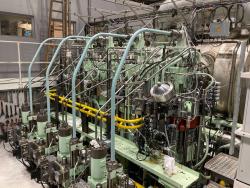
OR WAIT null SECS
© 2024 MJH Life Sciences™ and Turbomachinery Magazine. All rights reserved.
Vibration, noise and failure in rolling element bearings
Rolling element bearings can easily be affected by manufacturing errors, mounting defects or operational damage. This can lead to vibration, noise and even failure.
For example, time-varying nonlinear contact forces are generated by rolling-element bearings. These forces take place mainly between rolling elements, races and shafts. Complex effects have been seen during fault detection and vibration analysis of rolling-element bearings. Most noticeable ones are “nonlinear” effects, particularly force-deformation relationships that are complicated and highly nonlinear. There are various interface nonlinear (stiffness) effects such as the interfaces of bearing/shaft, bearing/support, etc. Most likely, axial load variations can be seen; therefore combined axial and radial loads are actually present in such bearings.
In addition, there are many localized effects and therefore there are complicated thermal and lubrication localized effects. Localized contacts play important roles such as the contact between rolling-elements and races, etc. The contact properties are very complex and should be described with detailed geometrical properties. Even small changes in the contact stiffness or parameters should be taken into account for accurate results and a reasonable vibration analysis. In addition, the bearing forces depend upon the velocities and motions.
Bearing Vibration
Theoretically, for a new/healthy bearing, the dominant frequency of vibration should be rolling-element passage frequency. The harmonics of this passage frequency can also be present; both sub-harmonics and super-harmonic can be generated by various mechanisms. The vibration spectrum and vibration amplitude could depend on many factors such as radial load, radial clearance (and pre-load), speed,etc. A valid question is how this vibration can be affected by proper selection of the bearings? By selecting correct number of rolling-elements and optimum amount of pre-load in the bearing, the vibration can be reduced. In simple terms, increasing the number of rolling-elements means increasing the number of supporting points, therefore increasing the system stiffness and reducing amplitudes of vibration. For a small number of rolling-elements, peak amplitudes of vibrations at the rolling-element passage frequency are significant. In other words, by increasing the number of rolling-elements, the peak amplitude of vibration decreases and rolling-element passage frequency is pushed to a higher value. All these can potentially reduce the vibration although there are certain practical aspects such as changes that should not cause new resonances, etc. For example, for a turbomachinery with rolling–element bearings, when a new bearing is selected and the number of rolling-elements increases from 5 to 11, the rolling-element passage frequency increased from 100 Hz to 220 Hz and the peak vibration reduced to less than 45% of the initial value.
There are two practical considerations: the first is the number of rolling elements should preferably be “prime number” such as 7, 11, 13, etc. The second is all relations are nonlinear. In other words, vibration amplitudes are nonlinear functions of parameters such as bearing clearance, preload, the number of rolling-elements, etc, and general or linear correlation cannot be presented.
The damping of a rolling-element bearing is relatively small; this damping usually exists because of the friction, structural damping, and small amount of lubrication (lubrication oil or grease). The damping of a rolling-element bearing is very difficult to calculate or estimate, since again it is highly nonlinear and originated from different sources extremely difficult to model or simulate. A low damping can usually result in a low decay rate of a bearing vibration.
Bearing Defects
Important defects related to rolling-element bearings are “dent on rolling-element”, “localized defect on a race”, “off-size rolling-element”, “waviness of rolling-element” and “waviness of the races”. Many other defects could affect rolling-element bearing operation; example is surface roughness. There can be many other localized and distributed defects. Combined with nonlinear characters, rolling-element bearing faults usually present complex and unexpected behavior patterns.
The manufacturer’s error could be prevented thorough inspections and testing programs.
There are also local defects which might be introduced during installation, commissioning, and early stage operation. Improper mounting of a bearing can cause some defects; for instance, a dent due to the plastic deformation of the rolling surface can happen. Another possible problem is debris; for example, grease/lubricant in the bearing can contain particle contaminants. Such a contaminant can affect the bearing like a local defect with the exception that the particle is free to move within the bearing.
Any defect can potentially cause new cases of resonances and high vibrations. For example, when the number of rolling-elements and the waves (for a waviness fault) are equal, there would be severing vibrations. As another example, for the outer race waviness, a sever vibration usually occurs when the rolling-element passage frequency or one of its harmonics coincides with a natural frequency. In addition to the above mentioned effects, dynamic effects of bearing defects should be carefully studied and evaluated.
As a consequence of a localized fault (such as a dent), the vibration could increase. Another important aspect of localized faults is that due to the different geometry of contact between the localized fault and bearing components, the contact-stiffness might change because of the different geometrical properties in the contact point.These two effects change the measured vibration. A damaged bearing usually produces small amplitudes of vibration in the high frequency band. For instance, for a small defect at an early stage of development, the response of the bearing and housing to the impact produced by such a small dent is a small amplitude of vibration with high frequency. A defect on a rolling-element can produce the vibration at two-times of the rolling-element’s rotational frequency (2×rolling-element’s rotational frequency).
“Brinell” damage and also “False Brinelling” damage are two types of bearing defects. The “Brinell” damage is characterized by permanent material deformation (without loss of material). Too often it occurs during one load event, whereas “False Brinelling” is characterized by material wear or removal and it usually occurs over an extended time from vibration, loads, etc.


